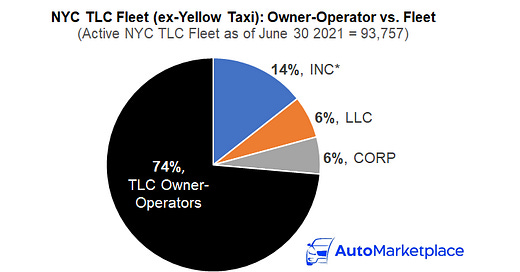

Discover more from AutoMarketplace
Who's To Blame for the Medallion Crash?
A Crain's NY investigative report found the TLC's inability to regulate Uber and Lyft is to blame for the yellow cab crisis. I think there is more to the story
A Crain’s investigative report argues inconsistent licensing practices and the light enforcement of regulations by New York City’s Taxi & Limousine Commission (TLC) allowed app-based companies, such as Uber and Lyft, to rapidly expand at the expense of taxis and liveries. The investigation focuses on the technicalities of how the rideshare companies entered the market and argues Uber and Lyft should not have been granted for-hire base licenses (i.e. black car, livery, and luxury limo bases).
"Uber is not a base. They have no base…[the law requires a black car base to be a physical location, from which cars are dispatched and where records are kept.] Their base is wherever the owner parks at night." - Christopher Lynn, TLC chairman from 1996 to 1998
"To have a base means you dispatch from a base…They don't dispatch from a base. They dispatch from cyberspace." - Transportation lawyer Daniel Ackman
"Uber and Lyft had been given an unfair advantage to the point they were able to grab market share…The TLC's failure to act, especially when these things were pointed out to them, led them to take market share away from legitimate businesses who were playing by the rules." - Steven Shanker, an attorney who represents the Livery Round Table
Granting rideshare companies for-hire base licenses (i.e. Uber operates 28 black car bases and 1 luxury limo base) allowed them to unfairly and illegally add tens of thousands of cars according to Crain’s reporter Brian Pascus. This ultimately destabilized the supply and demand dynamics of NYC’s for-hire transportation industry, collapsing the value of the yellow cab medallion (i.e. medallions now are thought to be worth $75,000 to $125,000, a ~90% decline from 2013 levels).
My Thoughts
According to the article, under TLC rules, a black car base is a central facility where cars are dispatched on a prearranged basis. The vehicles can either be owned by franchisees of the base or members of a cooperative that operates the base. Both franchises and cooperatives (i.e. driver-owned entities) require members to sign up and drive exclusively for one company, paying monthly dues to receive a share of profits. Freelancing (aka the “independent operator” model) was not allowed.
Uber and Lyft, at the time the companies launched (early 2010s), had a fairly novel business model that allowed passengers to “e-hail” via a smartphone. Technically speaking TLC drivers were given prearranged rides similar to a black car service. However, the rides were given quickly and on-demand via a smartphone app, which made it more similar in nature to a traditional street hail (i.e. hand hail). Of course, the NYC street hail was the sole domain of yellow cabs, which had medallions that gave them this right. Ultimately, the TLC concluded app-based companies performed functions more similar to a licensed black car base—the dispatch of cashless, prearranged trips—and allowed them to create their own bases (i.e. Uber-Vierzehn and Lyft-Endor). This was controversial, Uber, Lyft, Via and Juno technically were not dispatching from physical offices or setup as a franchise / co-op. Essentially, the app-based companies were given special treatment by the TLC, Pascus argues. In 2018 a special base category, the HV (high-volume) FHV base, was created to help officially establish rules for popular app-based companies.
"[through black car cases, app-based companies] were able to add the additional 85,000 cars to our streets—which in turn led to pollution, congestion, driver poverty, increased crashes and less use of public transportation" - Carolyn Protz, taxi medallion owner
While the argument has merits, it can be picked apart. One could argue the requirement to have a physical base location seems antiquated and fails to account for modern software and dispatching technology. Uber and Lyft were simply creating a platform that recognized smartphones could effectively be used to connect passenger demand to vehicle supply instantaneously. In a way it was pre-arranged (i.e. 5 minute wait), but it was also similar to a street hail (i.e. on-demand). That being said, I do agree that it shouldn’t have given the app-based companies the right to add as many cars as they did. This brings me to the second potential flaw in the argument that the TLC is solely to blame. City Council could not pass an FHV cap in 2015. This was the moment that would have directly addressed the issue, which in reality was about capping the number of vehicles Uber and Lyft could add.
The failure to pass the FHV cap in 2015 was a turning point for the yellow cab industry. If passed, it would have capped FHVs at a point where yellow cab medallion values could stabilize and even recover. When the FHV cap eventually did pass three years later in 2018, there were over 120,000 TLC-plated cars in NYC (Note: now the number has fallen below 100,000 due to the pandemic).
"Under the mandate and under the law, they had to protect the integrity of the franchise of the yellow cab. You keep the value of the franchise high… You don't let people dilute the value of the franchise by calling themselves a taxi." - Christopher Lynn, TLC chairman from 1996 to 1998
This is definitely a contentious and tricky issue to comment on, especially given the dire state of the yellow cab industry. At the end of the day, the above arguments are all important technicalities that can be debated. In reality though, these technicalities have and had a very real, sometimes tragic, impact on many families and businesses and that is not lost on me. That being said, was the yellow cab medallion system perfect? Were drivers treated well in that system? Were drivers happy? Did a few large fleet owners have an outsized influence on the lives of thousands of licensed TLC drivers who had no hope of affording a $1 million medallion? In fact, something not often spoken about is ~70% of all NYC app-based drivers own their own car now. Isn’t that a sort of freedom they never had before?
Obviously a lot of politics was involved from multiple sides and ultimately this likely delayed a better outcome. For example, why wait 3 years between 2015 and 2018 to cap FHVs, why not re-introduce the cap in 2016 or 2017 when it was obvious FHV growth was unsustainable? Furthemore, why is the solution always to cap vehicle supply? It doesn’t make any sense to me that a licensed TLC driver who’s worked in the industry for several years, doesn’t have the option to obtain their own TLC plate (Note: This would effectively be a soft FHV cap. It also wouldn’t kill the TLC rental industry. In fact it would cause more drivers to rent given they know they always have the option to buy).
I empathize with yellow cab medallion owners and do understand why they feel the City and the TLC failed to protect the medallion. Fundamentally, what else were they paying $500,000, $750,000 even $1,000,000 for? The fact that the City itself raised hundreds of millions in medallion auctions (as recently as 2014!) must also be upsetting.
That being said, I also think like all investments one cannot only enjoy the upside, but not accept the downside. For example, some articles (don’t want to reference specific names) mention drivers that bought medallions in the early 1990s for less than $200,000 who still currently have hundreds of thousands in medallion-related debt (i.e. they took equity out as the value rose). Personally, I am for a debt restructuring of medallion debt and believe the City has an obligation to use some of the funds it raised from recent medallion auctions to help pay down the debt of struggling yellow cab medallion owners. I also think demonizing Uber and Lyft is a road that leads nowhere. These were and still are disruptive companies that revolutionized how we all get around. That is not to say they are above regulations though.
AutoMarketplace.com NYC covers the for-hire transportation industry and automotive news. Check out AutoMarketplace.com on YouTube ▶️











